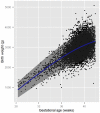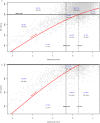Quantifying low birth weight, preterm birth and small-for-gestational-age effects of malaria in pregnancy: a population cohort study
- PMID: 24983755
- PMCID: PMC4077658
- DOI: 10.1371/journal.pone.0100247
Quantifying low birth weight, preterm birth and small-for-gestational-age effects of malaria in pregnancy: a population cohort study
Abstract
Background: The association between malaria during pregnancy and low birth weight (LBW) is well described. This manuscript aims to quantify the relative contribution of malaria to small-for-gestational-age (SGA) infants and preterm birth (PTB) in pregnancies accurately dated by ultrasound on the Thai-Myanmar border at the Shoklo Malaria Research Unit.
Methods and findings: From 2001 to 2010 in a population cohort of prospectively followed pregnancies, we analyzed all singleton newborns who were live born, normal, weighed in the first hour of life and with a gestational age (GA) between 28+0 and 41+6 weeks. Fractional polynomial regression was used to determine the mean birthweight and standard deviation as functions of GA. Risk differences and factors of LBW and SGA were studied across the range of GA for malaria and non-malaria pregnancies. From 10,264 newborns records, population centiles were created. Women were screened for malaria by microscopy a median of 22 [range 1-38] times and it was detected and treated in 12.6% (1,292) of pregnancies. Malaria was associated with LBW, PTB, and SGA compared to those without malaria. Nearly two-thirds of PTB were classified as LBW (68% (539/789)), most of which 83% (447/539) were not SGA. After GA 39 weeks, 5% (298/5,966) of non-LBW births were identified as SGA. Low body mass index, primigravida, hypertension, smoking and female sex of the newborn were also significantly and independently associated with LBW and SGA consistent with previous publications.
Conclusions: Treated malaria in pregnancy was associated with an increased risk for LBW, PTB, and SGA, of which the latter are most important for infant survival. Using LBW as an endpoint without adjusting for GA incorrectly estimated the effects of malaria in pregnancy. Ultrasound should be used for dating pregnancies and birth weights should be expressed as a function (or adjusted for GA) of GA in future malaria in pregnancy studies.
Conflict of interest statement
Figures



References
-
- Umbers AJ, Aitken EH, Rogerson SJ (2011) Malaria in pregnancy: small babies, big problem. Trends Parasitol 27: 168–175. - PubMed
-
- McCormick MC (1985) The contribution of low birth weight to infant mortality and childhood morbidity. N Engl J Med 312: 82–90. - PubMed
-
- Pulver LS, Guest-Warnick G, Stoddard GJ, Byington CL, Young PC (2009) Weight for gestational age affects the mortality of late preterm infants. Pediatrics 123: e1072–1077. - PubMed
Publication types
MeSH terms
Grants and funding
LinkOut - more resources
Full Text Sources
Other Literature Sources
Medical

